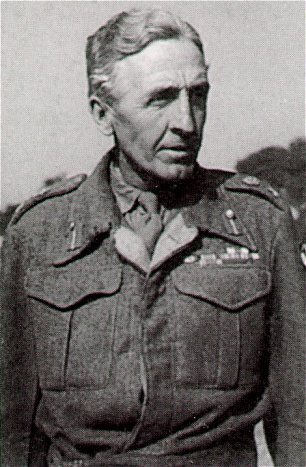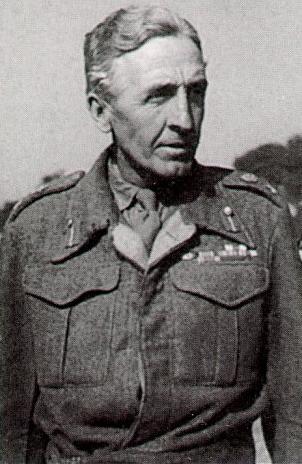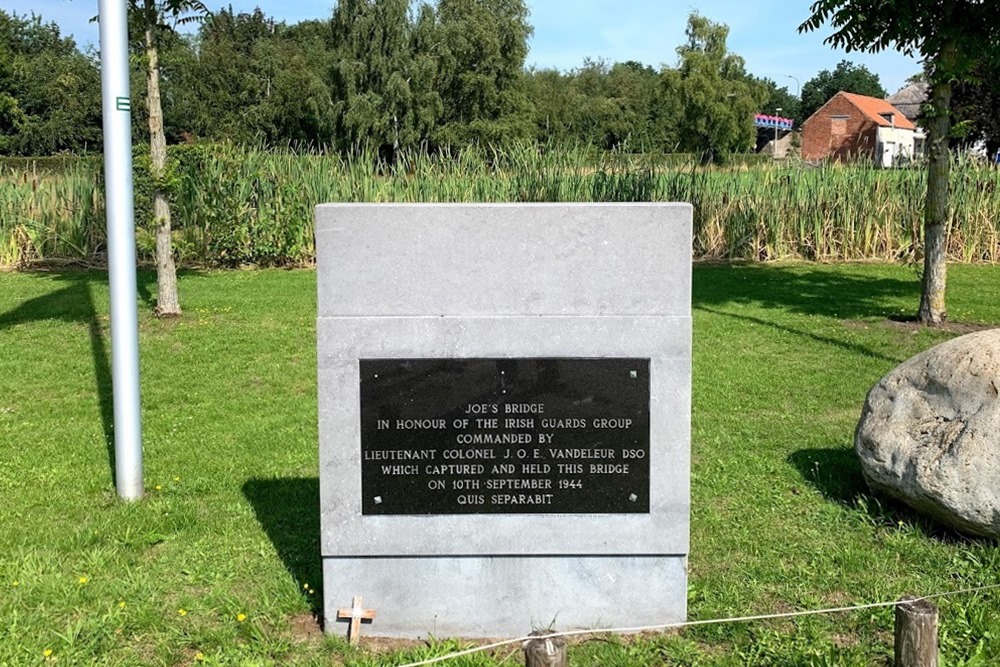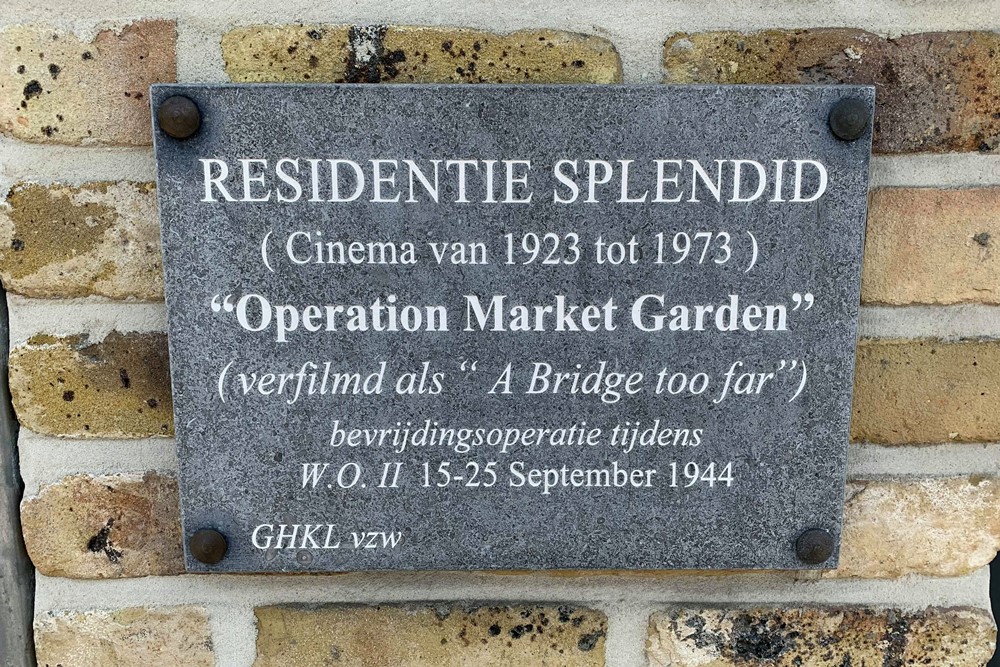Horrocks, Brian Gwynne "Jorrocks"
- Date of birth:
- September 7th, 1895 (Ranikhet, India)
- Date of death:
- January 4th, 1985 (England)
- Service number:
- 5821
- Nationality:
- British (1801-present, Kingdom)
Biography
Brian Gwynne Horrocks was born September 7th, 1895, in Ranikhet, India, the son of an army doctor. After graduating from boarding school in England, he attended the Royal Military College at Sandhurst. He was only a mediocre student, yet, at the outbreak of World War One, he was posted to the Middlesex Regiment. He was injured in October 1914, near Yper in Belgium and was taken prisoner. Despite various attempts at escape, he remained a POW for the remainder of the war. He returned to England but could not get used to the inactivitiy of peacetime. He found a way to return to active service. April 1919, he turned up in Vladiwostok, Russia fighting against the Bolsjewiks. During this war, he was again taken prisoner but despite various diseases he recuperated well after his release.
Horrocks' committment to his regiment, in which he served for 15 years, took him to places like Silesia, Germany and Wormwood Scrubs. 1938, he returned to Camberley as a member of the staff. He was to assess the needs for an impending war and organized short courses for future staff officers of the Territorial Army. When Germany invaded western Europe, Horrocks was sent to France and put in command of 2nd. Bat, Middlesex Rgt, itself part of General Bernhard Montgomery's 3rd Division. In July 1940, while still in France, Horrocks was promoted to Brigadeer and put in command of 11th Brigade. Under supervision by Alan Brooke and Bernhard Montgomery, Horrocks came out well during the retreat to Dunkirque.
March 1942, he was put in command of the newly established 9th Armoured Division. August 1942, Montgomery made him come to North-Africa to command 13th Corps. When he arrived, he was tasked with setting up a defensive line on the Alem-el-Halfa ridge to repel an attack by the German Afrika Korps. When the Germans attacked, they were not able to deploy their famous 88's against the British tanks; instead they came under fire from the British 7th Armoured Division and from the Allied Desert Air Force. On September 2nd, 1942, after fierce fighting, it became clear to the Germans that the battle was lost and a demoralized Rommel gave orders for a strategic withdrawal. German losses had beem substantial and Rommel had been tought his first lesson.
Following the battle of Alem-el-Halfa, Horrocks was offered the post of commander of 10th Corps but he turned it down, arguing that he rated hinself no better than the incumbent commander, Herbert Lumsden and so he remained in command of 13th Corps. After the battle at El Alamein however, he was named commander of 10th Corps. During Operation Pugilist in the south of Tunisia, Horrocks executed one of his most successfull attacks of the war. Montgomery had planned an assault on the Mareth Line, a frontal attack in combination with a 200 mile deep flanking attack to the south. After the frontal attack had bogged down, Montgomery decided to re-inforce the troops moving south with, among others, Horrocks' men. March 27th, the Tebaga Gap was breached, rendering the defensive line untenable and forcing the Axis forces to abandon their positions. In April 1943, during the last stages of the Tunisia campaign, Horrocks volunteered to command 9th Corps, part of the British 1st Army commanded by Lieutenant-general Sir Kenneth Anderson. In June 1943, Horrocks was seriously injured after having been hit by gunfire from a wandering German airplane
In September 1943, he flew back to England, accompanied by American Lieutenant-general Omar Nelson Bradley. Back home, doctors told him he would never again lead his men in battle. He found a little comfort in being awarded the title Companion of the Order of the Bath and the conferment of the DSO. Anyway, a year would pass before he would be named commander again. Being one of Monty's favourites, he was appointed to replace Lieutenant-general Gerard Corfield Bucknall of 30th Corps in late August 1944, who had fallen from grace. As officer commanding, he led 30th Corps in the fighting in the Falaise Pocket where the Allies defeated the German 7th Army. Horrocks remained in command of 30th Corps during its drive through Belgium. He liberated the Belgian capital of Brussels and at one time had advanced 300 miles in just six days. Horrocks' drive was halted as he received orders to capture the port of Antwerp. After the war he regretted this decision because it gave the Germans time to recuperate. The port of Antwerp was vital to the Allied cause as all deep sea ports on the French coast would remain in German hands until May 1945 and so all supplies still had to come all the way from Normandy. In September 1944, without anyone being aware of it, 30th Corps faced just one single German division but by the time preparations for the attack northwards had been completed, the Germans had deployed their 1st Fallschirmarmee (Paratroop army) of Generaloberst Kurt Student.
In mid-September, 30th Corps was sent east and the Canadian 1st Army was tasked with clearing the German fortified defensive line running from Antwerp on both sides of the river Scheld to the North Sea. Meanwhile, General Montgomery had devised Operation Market Garden which was to be the main objective of his 21st Armygroup. 30th Corps under the command of Horrocks would spearhead the attack on the ground, ultimately to link up with the British 1st Airborne Division at Arnhem. 1st Airborne had been told that 30th Corps would relieve them within two days. When battle was joined, German Armygroup B commanded by Generalfeldmarshall Walter Model launched a series of counter-attacks, forcing Horrocks' units into the defensive. The terrain through which Horrocks' men had to advance was not suitable for their mission either. Often whole divisions were hindered in their drive and they had to advance along a single highway, later to be known as Hell's Highway. In the end, Horrocks' ground attack failed and he could not link up with the beleaguered 1st Airborne at Arnhem. He was however not held personally responsible for the failure of his Corps.
At the end of 1944, he was sent home on sickleave. In March 1945, he had returned however and led his Corps across the river Rhine. From there they advanced further into Germany, liberated the city of Bremen and came eye to eye with the horrors of Sandbostel concentration camp.
Horrocks was knighted in July 1945 but he remained in the army. From 1946 to 1948, he was General Officer Commanding Western Command and from 1948 to 1949 General Officer Commander-in Chief British Army of the Rhine in Germany. 1949, owing to bad health as a result of the injuries he had sustained in North-Africa, he was declared physically unfit for service. After his retirement he became Gentleman Usher of the Black Rod, a function within the British House of Commons and from 1963 to 1977 he was chief executive of a contracting firm. During the sixties, he enjoyed a successfull career hosting a number of television documentaries on military history. He continued this success writing a number of books on the history of various British regiments. In the last years of his life, he remained active in charity work and ultimately was dealt a severe blow in 1979 when his daughter and only child drowned while swimming in the river Thames.
Sir Brian Gwynne horrocks, KCB, KBE, DSO, MC died Janaury 4th 1985.
Do you have more information about this person? Inform us!
- Period:
- First World War (1914-1918)
- Rank:
- Captain
- Awarded on:
- January 30th, 1920
- Period:
- Second World War (1939-1945)
- Rank:
- Temporary Major-General
- Unit:
- Headquarters, XIII Corps, British Army
- Awarded on:
- December 31st, 1942
He has rendered distinguished services during both battles."
- Period:
- Second World War (1939-1945)
- Rank:
- Temporary Major-General
- Unit:
- Headquarters, IX Corps, British Army
- Awarded on:
- June 24th, 1943
- Period:
- Second World War (1939-1945)
- Rank:
- Major-General
- Unit:
- Headquarters, IX Corps, British Army
- Awarded on:
- August 5th, 1943
- Period:
- Second World War (1939-1945)
- Rank:
- Major-General
- Awarded on:
- June 20th, 1944
- Period:
- Second World War (1939-1945)
- Rank:
- Temporary Lieutenant-General
- Unit:
- Headquarters, XXX Corps, British Army
- Awarded on:
- 1944
- Period:
- Second World War (1939-1945)
- Rank:
- Temporary Lieutenant-General
- Unit:
- Headquarters, XXX Corps, British Army
- Awarded on:
- 1944
- Period:
- Second World War (1939-1945)
- Rank:
- Temporary Lieutenant-General
- Unit:
- Headquarters, XXX Corps, British Army
- Awarded on:
- March 20th, 1945
- Period:
- Second World War (1939-1945)
- Rank:
- Temporary Lieutenant-General
- Unit:
- Headquarters, XXX Corps, British Army
- Awarded on:
- July 5th, 1945
- Period:
- Second World War (1939-1945)
- Rank:
- Temporary Lieutenant-General
- Unit:
- Headquarters, XXX Corps, British Army
- Awarded on:
- August 7th, 1945
- Period:
- Second World War (1939-1945)
- Rank:
- Temporary Lieutenant-General
- Unit:
- Headquarters, XXX Corps, British Army
- Awarded on:
- October 17th, 1946
- Period:
- Second World War (1939-1945)
- Rank:
- Temporary Lieutenant-General
- Unit:
- Headquarters, XXX Corps, British Army
- Awarded on:
- January 16th, 1947
With Palm.
- Period:
- Second World War (1939-1945)
- Rank:
- Temporary Lieutenant-General
- Unit:
- Headquarters, XXX Corps, British Army
- Awarded on:
- January 16th, 1947
With Palm.
- Period:
- Second World War (1939-1945)
- Rank:
- Temporary Lieutenant-General
- Unit:
- Headquarters, XXX Corps, British Army
- Awarded on:
- June 9th, 1949
- Period:
- Second World War (1939-1945)
- Rank:
- Lieutenant-general
- Unit:
- Headquarters, XXX Corps, British Army
War Diary mentions
15 August 1944 WO 171/846 - 15-19 The King Royal Hussars
The C.O. went forward with Brigadier R.A.C. 2nd Army, to meet G.O.C. 30 Corps – Lt.Gen. B.G. Horrocks CB., DSO., MC., and G.O.C. 11 Armd. Div. – Maj.Gen. G.P.B. Roberts DSO., MC. Further arrangements about re-equipping and movement of the Regt were made. The Regt was to take over a complete new establishment of Cromwell and Challenger tanks from No. 2 A.R.G. situated just North of BAYEUX and to complete itself to establishment in B vehs, partly with new vehs drawn from this A.R.G. and partly by taking over vehs from 2nd Northants Yeo. The Regt was to replace the 2nd Northants Yeo as Armd Recce Regt to 11 Armd Div. The 2nd Northants Yeo were to be disbanded and amalgamated with their 1st line Regt. The whole situation was somewhat complicated by political difficulties over the disbandment of the 2nd Northants Yeo, and the fact that the Secretary of State had not yet given his agreement to this, which prevented the Corps Comd and Div Comd or the Regt itself being informed what was going to happen till this day.
12 September 1944 WO 171/1257 - 3 Irish Guards
A quiet day was spent by the Bn in rest and maintenance, and received a visit from the Corps Comd (Lt. Gen. Horrocks) to congratulate those concerned in the capture of the bridge over the ESCAUT Canal, which had already been christened and sign-posted “Joe’s bridge” in honour of the C.O.
The only cas suffered today was one OR wounded.
16 September 1944 WO 171/846 - 15-19 The King Royal Hussars
A fine Sept day. Regt still in same posn supporting 231 Bde in the br hd. Still some shelling and a certain amount of activity all around but not determined counter attack developed during the day. The br hd was strengthened by 9th Bn DLI who came in on the S.E. corner of the br hd thus allowing the Dorsets to move further North and make stronger link with the Devons in the North. C.O. attended a talk by the Corps Commander - Lt-Gen BG Horrecks CB., DSO, MC and the Commander 2nd Army Lt-Gen Sir Miles Dempsey KCB, DSO, MC at BOURG LEOPOLD 2683. On this the Corps Comd spoke of the adv during the past fortnight, the present situation and the operation Market Garden which was due to begin the following day. This operation was to be an adv by 30 Corps from the br hd up to the Zuider Zee to dominate the country West of this, thereby cutting off communication between Germany and the Low Countries and thus it was hoped trapping what German forces were left in France and the Low Countries, and also cutting off V.2. bases in this area. 30 Corps was to adv on one centre line through EINDHOVEN 4218 - ST OEDENRODE 4232 - GRAVE 6153 - NIJMEGEN 7062 - ARNHEM 7477 - APELDOORN 7803 - EEP 8018 - NUNSPEET 6621 with 8 Corps (11 Armd Div, 3rd Inf Div) protecting their right and rear and 12 Corps (7Armd Div, 4 Armd Bde, 15 (S) Div and 53(W) Div) operating on their left flank. A large part was also being played in this operation by Airborne Forces, 1st British Airborne Div with the Polish Para Bde was to capture intact the bridges over the Nederrijn at ARNHEM and dominate the surrounding countryside. 82 US Airborne Div was to capture intact the bridges over the Maas en Waal in areas GRAVE en NIJMEGEN and to dominate the surrounding country.101 US Airborne Div was to be dropped in the area between EINDHOVEN en GRAVE with the task of facilitating the adv of 30 Corps as far as the R. Maas. The Corps Comd expressed the opinion that if this operation was as successfull as he hoped he thought that it might be the decisive battle of the war and finally finish the German Army. The Regt's task in this operation was as follows:- with under comd 'A' Sqn The Royals (Maj J Bowlby), 1 Bty 86 Fd Regt RA (Herts Yeo) to adv behind the leading Bde of Gds Armd Div to the EINDHOVEN - ST OEDENRODE area and there come under comd 101 US Airborne Div whose task it was to keep open the Corps Axis of advance between VALKENSWAARD 4108 and VEGHEL 4737 and to prevent the enemy interference on this axis from either flank.
28 September 1944 WO 171/1286 - 4 Dorsets
Corps Comdr. Lieut-Gen. Horrocks spoke to all Offrs, W.O’s & Sjts of the Bn.
21 October 1944 WO 171/1302 - 6 Green Howards
All officers and NCO’s down to Cpl paraded in the Divisional Theatre in NIJMEGEN and heard a most interesting description of the "Drive into Holland” given by the Corps Comdr (Gen Horrocks, 30 Corps).
14 October 1944 WO 171/1257 - 3 Irish Guards
The Corps Comd (Lt. Gen. Horrocks) gave a lecture to Offrs, WOs and 8jts in the div club in GRAVE. He congratulated the Div on its performance of the battles of the past and explained in detail the course that ops had taken and the reasons which lay behind various moves which we had been compelled to make. Finally he concluded with a brief forecast of future ops, which now depended entirely on the clearing of the harbour at ANTWERP, which was the only means of getting adequate supe for a final thrust into GERMANY itself.
18-21 October 1944 WO 171/1398 - 5 East Yorkshire
Bn remained in NIJMEGEN. 21 Oct visit by Comd 30 Corps Lt.-Gen. Horrocks who addressed all officers and N.C.Os.
20 October 1944 WO 171/1286 - 4 Dorsets
Offrs and Sjts of the Bn attended a lecture by the Corps Comd Lt Gen Horrocks at HATERT 6858. The Comd talked of operations taken place through HOLLAND and congratulated 43 Div on its fine performance. Future operations were mentioned and all men were to take full advantage of the approx 3 weeks that lay before us before a big offensive was likely to take place, in training and preparing for the 'Battle of Germany'.
21 October 1944 WO 171/838 - 4/7 Royal Dragoon Guards
During the past week Lieut. General B.G. Horrocks, C.B., D.S.O., Comd. 30 Corps had given a talk to members of 43 Div. on the last big operation, i.e. advance into HOLLAND with a few details of the future. A few Officers, WOs and Sergts. of the Regiment were allowed to attend.
15 November 1944 WO 171/837 - 2 Household Cavalry
GOC 30 Corps Lt.Gen. Sir B. Horrocks C.B., DSO visited the Regt in the Casino Cinema. The address was most inspiring being devided into three parts (a) Praise of and an account of the doings of 2 HCR (b) An account of the adv and ops carried out by 30 Corps (c) A foreword of the future in which he prophesised that we should have to fight all the way to BERLIN. The whole Regt was most proud and greatly inspired by Gen. Horrock's address.
Leave was now being given out on a more generous scale - for offrs 48 hrs came round about once a month and the excellent Eye Club run at BRUSSELS for personnel of Gds Armd Div was a great success - for other ranks owing to the vast numbers involved arrangements were at first slow but by the end of the month 3 schemes for leave to ANTWERP and BRUSSELS was in force and about 40-50 per week were sent off.
Appx D Gds Armd Div Diary for Sep
27 November 1944 WO 171/858 - 1 Lothians and Border Yeomanry
Aft.: Lt. Gen. B.G. Horrocks, CB., DSO., MC (GOC., 30 Corps) visited HQ., Drewforce and inspected and addressed a Parade consisting of a party from each of “A” Sqn., 141 RAC., 617 ASRE., RHQ/B Sqn/C Sqn., 1 Lothians,
Regt. Party was composed of 22 Officers and 64 ORs. of B.&.C. Sqns & RHQ, most of whom had taken part in the recent ops in sp 84 U.S. Inf. Div. and 43 (Wessex) Inf. Div. (30 Corps).
Lt. Gen. Horrocks was introduced to all the officers and spoke to many of the men, while inspecting the parade. In his address afterwards, the Corps Commander gave a brief description of the last operations, telling us the general plan and giving an indication of future activities. He was loud in his praise for the “Funnies”.
The turn-out on this Regt. Parade was very good.
B.&C. Sqns & RHQ – Maintenance, etc.
28 December 1944 WO 171/1306 - 7 Hampshire Regiment
Commander 30 Corps (Lt Gen Horrocks) visited Bn HQ during the afternoon. His visit coincided with an unusually heavy stonk in the vicinity of Bn HQ. No cas were caused. Relief by 7 Som L.I. was carried out without incident except for one slight casualty & Bn moved into billets in villages of TEVEREN & GROETENRATH.
30 November 1944 WO 171/858 - 1 Lothians and Border Yeomanry
Aft.: G.O.C. 79 Armd Div (Maj Gen Sir Percy C.S. HOBART KBE, CB, DSO, MC) visited DREWFORCE HQ and talked to the Commanding Officer.
C.in C. 21 Army Group (Field Marshal Sir Bernard L. MONTGOMERY KCB, DSO) visited DREWFORCE HQ accompanied by G.O.C. 30 Corps (Lt. Gen B.G. Horrocks CB, DSO, MC,). He was introduced to a party of DREWFORCE Officers, including the following from the Regiment:- Commanding Officer, Second-in-Command (Major I.S. BALMAIN) Adjutant (Capt. A.J.P. Scott) Os.C. and 2 i/cs “B” and “C” Sqns (Major R.K. WATSON Major R.G. BENNETT, Capt J.D. HENDERSON, Capt. R.S. HENMAN). He examined a Crab, a Crocodile and an AVRE. The Crab, with crew commanded by Cpl. Imrie, was supplied by “B” Sqn.
3 December 1944 WO 171/867 - 5 Royal Tank Regiment
Visit by 30 Corps Comd - Lt. Gen Horrocks otherwise no event.
5 December 1944 WO 171/839 - 5 Royal Inniskilling Dragoon Guards
Lieut-General B.G. Horrocks, CB, DSO, MC, Comd 30 Corps, visited the regiment and addressed all Squadron Leaders.
8 December 1944 WO 171/1302 - 6 Green Howards
Field Marshal B.L Montgomery addressed aIl Officers of the Div at YPRES. The Field Marshal gave a resume of the campaign up to the present date. A message was received from the Corps Comd (Gen Horrocks 30 Corps) who tendered best wishes to the Div in their new role and hoped to meet many members of the Div, if not in 50 Div, at least as individuals in new regts, and fighting as with the same vigour as before. He closed his message by saying, "The TT Boys will be much missed by everyone."
Sources
- Photo 1: Public Domain Great Britain
- - Smart N., Biographical Dictionary of British Generals of the Second World War, Pen & Sword Books Ltd., Great Britain, 2005
- Margry K., Operation Market-Garden Then and Now, After the Battle - Battle of Britain International Limited, 2002
- Onderscheidingen.nl
- Unithistories.com
- https://www.thegazette.co.uk/London/issue/31759/supplement/1229
- Recommendation for Award for Horrocks, Brian Gwynne Rank: Major General ... | The National Archives
- Recommendation for Award for Horrocks, Brian Gwynne Rank: Colonel Regiment: ... | The National Archives
- Recommendation for Award for Horrocks, Brian Rank: Colonel Award: Legion of... | The National Archives


















